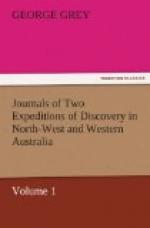CONTINUE THE COURSE TO THE NORTHWARD.
The coast now trended north by west and we continued to run along it. After passing Mangrove Point the sandy dunes along the shore ceased, and the land appeared to be scarcely elevated above the level of the sea: not a hill or tree could be perceived, and a low black line almost level with the water’s edge was the only indication that we had of being near land.
LYELL’S RANGE.
This kind of shore continues for about nine miles, when low sandhills begin to rise parallel to the coast, and these gradually increase in altitude until they form that remarkable range of dunes which I have called Lyell’s Range. When it wanted about an hour to sunset we had made about twenty-five miles, and then ran in closer along the coast to look either for a boat harbour or some spot at which we could beach them. But nothing suited to our purpose could we see: the coast was straight, sandy, exposed and lashed by a tremendous surf; the wind now freshened considerably and the sky looked very threatening; we had therefore no resource left but either to run to the northward before the breeze or to beach the boats. I chose the first alternative; and we coasted within about a quarter of a mile of the shore, just outside the surf, looking out for any spot which gave us the least hope of beaching in safety.
BEACH THE BOATS.
As the sun sank so freshened the breeze, until it blew a good half gale of wind, and everything gave indications of approaching foul weather. This was no coast to be on during a stormy night in heavily laden whale-boats; and as it now began to grow dark I determined at all hazards to beach rather than be driven out to sea in a gale of wind. I accordingly ran my boat in through the surf, leaving the other one outside to see what success we had before they made the attempt.
BOAT SWAMPED IN BEACHING.
The surf was very heavy but the men behaved steadily and well; and through it we went, dancing along like a cork in a mill-pond; at last one huge roller caught us, all hands gave way, and we were hurried along on the top of the swelling billow, which then suddenly fell under us and broke; in a moment after we had grounded, and although still upwards of two hundred yards from the shore, we all jumped out to haul the boat up, but ere we could move our heavily laden whaler beyond a few yards breaker after breaker came tumbling in and completely swamped it. We continued to haul away and presently found ourselves swimming. In fact the whole coast hereabouts was fronted by a kind of bar of sand, distant about two hundred yards from the shore, with not more than two feet water on it. Between this and the shore the water was tolerably smooth and two fathoms deep. It was upon this outer bar that we had struck, and the other boat experienced the same fate as ourselves. We of course passed a miserable night in our drenched and wretched state; but it was at all events some comfort, when we heard during the night the boisterous wind blowing outside, to feel that we were safe ashore.




